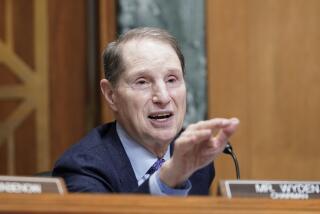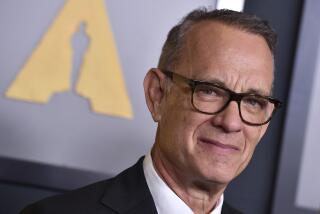Practice or Publicity: the Heart of the Matter
- Share via
Modern medicine, according to some critics, has become a high-tech circus whose barkers see a vast, largely untapped profit source. If that is partly true, the artificial heart--and the hoopla surrounding it--constitute the circus’s noisiest sideshow.
The recent attempt in Tucson--temporary use of an artificial heart that was not authorized for experimental use by the U.S. Food and Drug Administration--raises new arguments about what is mercy and what is emergency and what is valid experimentation. The Tucson surgeons were, at least, only using the device until a human heart was found for transplanting.
The FDA did approve for the first time last week a temporary artificial heart designed to keep patients alive until a replacement can be found. The pneumatic air-powered heart was developed at the Hershey, Pa., Medical Center by Dr. William Pierce and others. There were no current candidates to receive it.
But heart-implant news is always big news. Since December, 1982, the nation’s attention has been drawn four times to the implantation of an artificial heart, a device that began--and arguably should have stayed--as a cautious, tenuous experiment intended to buy time for doctors trying to save severely ill patients.
What has happened, in the view of many cardiologists and heart surgeons, is that the artificial heart has become less a research initiative than a promotional device for Humana Inc., a for-profit hospital chain. Humana hired away the Salt Lake City team, headed by Dr. William C. DeVries, that pioneered the Jarvik-7 heart. Critics suggest that Humana is using the artificial heart as a merchandising-publicity tool, pointing out that Humana hasn’t had a recognized research program in heart disease.
As a promotional tool, the artificial heart has already enjoyed great success. After Humana lured away the University of Utah Medical Center artificial-heart team, the first of what Humana claims will be 100 implants (the FDA has sanctioned only seven) was performed on William J. Schroeder. Right after the heart was turned on, Schroeder was photographed drinking beer and eating ice cream (life-style habits that may well have played an earlier role in the severity of his heart disease). President Ronald Reagan called to extend congratulations--a phone call that typifies what many physicians call a confusion of priorities surrounding the artificial heart. One such critic is Dr. Thomas Preston, chief of cardiology at the University of Washington’s Pacific Medical Center in Seattle.
“There is a great impropriety in teaching people to idolize ‘heroes’ like Barney Clark (the first Jarvik heart implantee) and Bill Schroeder,” Preston said, “rather than the thousands of people who are dying every day for many reasons, including inadequate medical care.
“Then President Reagan called Schroeder and, in so doing, he chose not to call millions of people in this country who have serious problems but who can’t get care. He sends the message that this is the sort of people we glorify and I think that’s wrong. It is teaching people to rely on medical ‘miracles’ rather than taking care of themselves.”
Two problems, say some experts, have been ignored or underexplored in the orgy of attendant artificial heart publicity.
The first is medical. Even assuming today’s artificial heart works, and the survivals of the patients in the most recent episodes don’t yet establish the device as anything more than experimental--in need of much more research and development--the mechanical heart’s prospective uses are limited and its role confined to a handful of people with severe heart disease.
Preston says that in what he thinks of as the “big picture” of significant health problems and issues, the artificial heart is of “very, very little significance.” For mechanical heart replacements to be anything more than a curiosity, they would have to be capable of functioning for years at a time without any components outside the body. Even the so-called portable power pack first used in the Schroeder case, Preston and other doctors agree, does nothing to avoid inherent problems of unavoidable infection posed by extracorporeal components.
Surgeons and cardiologists generally agree that, even if an artificial heart can be made to work for several months at a time, the only potential use in clinical medicine is as a stopgap, to keep patients alive until a suitable donor heart can be found for transplantation. Dr. Jack G. Copeland, the surgeon who implanted the “Phoenix heart,” tended to confirm that limited use at a heart medicine convention in Anaheim last week.
Transplantation itself is a procedure that has only recently found limited clinical use after years of media coverage. Heart techniques have been embraced by news media because more important stories of medicine are less spectacular and far harder to tell.
The second issue is ethical: Inherent in the mechanical heart controversy are the practical economics of medicine and the growing role of for-profit enterprises. Much heart disease is preventable--by diet, exercise and other daily-life modifications. Now that coronary artery bypass surgery is being seriously questioned, there is growing emphasis on treatment initiatives that cost less than expensive surgery and actually stand some chance of curing the disease--which bypass and the artificial heart generally do not.
Preston figures that as many as 50,000 people a year suffer heart disease so serious that they might benefit from artificial hearts--if the device could be made to work reliably. Selling all of them such hearts could cost as much as $10 billion in today’s dollars. “It raises ethical questions,” said Preston, “when we have already entered the era of health care rationing.”
Barton J. Bernstein, a Stanford history professor who is working with others at the Stanford Medical Center on a book about biomedical innovation and public policy, also questions cost.
“Why should money be spent on the artificial heart rather than on finding ways to help people prevent heart disease?” Bernstein wrote in Technology Review, a Massachusetts Institute of Technology publication. “Perhaps an ideal society with unlimited resources could do both, but this is not such a society.”
This is where the motives of the artificial heart’s promoters come into question. Before bringing the Salt Lake City team to Louisville, Humana was not well-known for heart disease research or treatment.
“Humana is a commercial corporation whose stated objective is to make money,” said Dr. Bruce Lytle, a staff surgeon at the famed Cleveland Clinic, where bypass surgery and many other developments in heart medicine have been pioneered. “I don’t think they make any secret that they are using this (the artificial heart) as a loss leader, so to speak.
“They wish to become well-known to publicize their commercial venture. . . . This is American business and that’s the way it works.”






